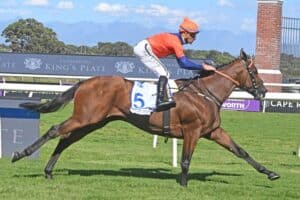Equinox has been installed as a short-priced favourite for France’s Prix de la Arc de Triomphe.
He was described as a bay horse in the race card, but Ushba Tesoro’s head and chest looked a pale-beige hue after he’d won the $10-million Dubai World Cup at the weekend.
That told a story. The giant six-year-old had come from stone last in the 15- horse field, with uncommon stride and power, disregarding great clumps of dirt kickback hitting his face, to churn past some of the best horses in the world and claim the famous trophy.
Jockey Yuga Kawada was equally sand splattered as he saluted the 80,000 crowd at Meydan Racecourse and signalled that Japan had not just arrived as a power on the global stage but was now dominating it.
Noburu Takagi-trained Ushba Tesoro’s victory was the second for Japan in the World Cup after Victoire Pisa’s triumph in 2011, but whereas that earlier moment was greeted with a degree of patronising surprise, this one saw full acknowledgement that the Land of the Rising Sun was top of the racing tree.
If you’d said 20 years ago that Japan would have the US, the UK and Australia playing catch-up so soon you’d have been laughed at.
In 2022, Japanese raiders won five of the eight races at the World Cup meeting. This year it was just three, but they included two of the most important – the Cup and the Group 1 Sheema Classic.
In-form Equinox
And Ushba Tesoro’s stirring performance wasn’t even regarded as his nation’s best showing on the day.
That accolade went to Equinox’s demolition in the Sheema, with jockey Christophe Lemaire never letting his mount off a tight hold as he cruised to the line and broke the 2400m turf course record.
Highly rated opposition looked like hacks, flailing in his wake.
Equinox has been installed as a short-priced favourite for France’s Prix de la Arc de Triomphe, maybe the top middle-distance race in the world.
Ushba Tesoro might also ship to Longchamp in late September, but he seems to prefer a dirt surface to turf.
How did Japan gallop past other great racing nations in a few short years?
The truth is it hasn’t been all that quick and is, in fact, the result of more than 40 years of careful thoroughbred breeding and the product of a fanatical racing culture going back even further.
Horse racing on the islands traces to the eighth century, and the modern version of it to the 1860s and British influence. Despite a keen betting culture and packed racecourses, further outside influences were limited in the 20 th century.
One son of legendary stallion Northern Dancer was imported from the US, Northern Taste, and, in winning 10 sire championships, was key to improving Japanese bloodlines.
‘We were shocked!’
A fateful date was 1981, when Japan’s racing officials staged a Japan Cup – then the world’s richest race – to test their horses against the best from other countries.
“We were shocked! Our horses were such a slow!” comments racing analyst Naohiro Goda in an interesting YouTube video on the subject.
The drubbing by visitors fired up the well-known Japanese determination and industriousness.
The pivotal move was the Yoshida family buying 1989 Kentucky Derby and Preakness Stakes winner Sunday Silence for their stud farm on the northern island of Hokkaido. It changed everything. He was champion sire for 13 years but, more importantly, produced a long list of sons and daughters who were themselves phenomenal at stud.
The most famous of these was Deep Impact, whose blood now covers the globe. In Sunday Silence’s third crop was Stay Gold, the father of Oefevre, the father of Saturday’s hero Ushba Tesoro.
Stay Gold’s victory at the 2001 Hong Kong International meeting was Japan’s first foreign Group 1. In 2005, Cesario whipped the US’s top fillies in the American Oaks, but it was the 1-2 of Delta Blues and Pop Rock in the 2006 Melbourne Cup that really stirred things up. The duo streaked away from Australia’s finest to proclaim something was stirring out east.
Successful, targeted raids around the world in the past few years have grown into invading armies, with 26 Japanese runners at Meydan. The taste for foreign currency purses won’t be easily satisfied.






